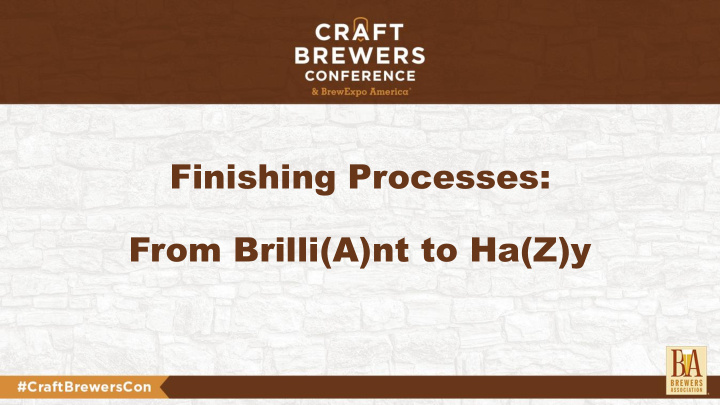



Finishing Processes: From Brilli(A)nt to Ha(Z)y
John Mallett Aaron Moberger Lead Cellar Operator Cellar Manager Mass Bay Brewing Co. Mass Bay Brewing Co.
Objectives Provide overview of finishing processes Review finishing and stabilization regimens for: Pilsner English Ale Witbier New England Style IPA How to tweak your equipment to suit several different styles Performing efficient changeovers between styles
Goals of Finishing Appearance While appearances vary significantly, still an integral component of style Indication of whether we finished the beer to our standards Stability Should be the same when we would pull it off the shelf as it was on day one Flavor Remove bitterness, “roughness”, yeast and/or hop bite Results based as much on design and upstream processes as on day-of finishing process
How? Conditioning Finings Select Separation removal of • In tank particles • Centrifuge • Filter
General Recommendations Start from your end goal and work backward Pay attention to upstream practices Set up templates for producing similar styles Put a premium on operator training
Conditioning Time Temperature Colloidal stability Protein/polyphenol complexes, precipitation Flocculation and sedimentation of yeast
Finings Overview Typically work by binding either to yeast/proteins or tannins/polyphenols Proteins: isinglass, silica, tannic acid Tannins: PVPP Some products are a combination Larger, denser particles settle faster Hot and cold side options Yield and chill proofing benefits
Separation – Settling Settling in fermentation vessel, bright tank, centrifuge Stokes’ Law 𝑊 = settling velocity 𝜍 𝑞 = particle density 𝑊 = 2 𝜍 𝑞 − 𝜍 𝑔 𝜍 𝑔 = fluid density 𝑆 2 9𝜃 𝜃 = viscosity = force of gravity 𝑆 = particle radius
Silica Finings Can be used either in tank or inline FDA: silica can be used as a stabilizer in production of beer provided it is removed by filtration prior to final processing Use lowest effective dose and size finishing filters to remove particles prior to packaging — consult suppliers on particle sizes and finish filter recommendations Can be combined with PVPP for two-part stabilization
Sample In-Tank Silica Process • Day 0 – 5: Ferment completely • Day 12: Rack off cone, transfer through 5 μ cartridges to BBT • Day 6: Crash to 40 F • Day 13: Carbonate • Day 8: Dump yeast • Day 14: Package • Day 9: Mix silica xerogel slurry at 0.15 lbs per bbl & crash to 30 F
PVPP finings More expensive than silica but used at lower rates Generally later in process, combined with or after silica Per FDA, can be used in beer as a clarifying agent, at a residual level not to exceed 10 ppm Use lowest effective dose and size filters accordingly
Separation - Filtration Darcy’s Law: Q = flow rate Φ = permeability 𝑅 = Φ 𝑄𝐵 P = pressure drop A = surface area 𝑀𝑁 L = thickness M = viscosity
Types of Filters Pressure Leaf Crossflow Sheet Cartridge
Cartridge Filters Cheaper asset cost Simple to operate Possible to store cartridges for reuse Media more expensive
Sheet Filter Wide range of media for different applications Cellulose DE (adsorptive) Carbon Sometimes configured in two stages, coarse/fine Sheets can be backflushed and cleaned in place Photo courtesy of ATP Group
Pressure Leaf Filter Generally highest Δ Ps Media relatively cheap High capacities Flow rate Sludge Overall throughput Complicated to operate Dust handling Disposal Photo courtesy of ManCel Associates
How to finish a… • German-style Pilsener • English Brown Ale or ESB • Belgian-style Witbier • Juicy or Hazy IPA
German-style Pilsener BA style guideline: Appearance should be clear. Chill haze should not be present. • Lager for 2-4 weeks • Finings for clarity and stability • Consider polish filtration and chill proofing
English Brown Ale or ESB BA style guideline: Chill haze is acceptable at low temperatures. • Use a flocculant yeast strain • Condition cold for a week or more • Consider using finings, which must be removed by filtration
Belgian-style Witbier BA style guideline: Unfiltered starch and yeast haze should be visible. Wits are traditionally bottle conditioned and served cloudy. • Dump yeast and rack to BBT, consider using coarse filter through transfer • If you have a centrifuge, you can adjust bowl and product speeds to tune haze
Juicy or Hazy IPA BA style guideline: Low to very high degree of cloudiness is typical of these beers. Starch, yeast, hop, protein and/or other compounds contribute to a wide range of hazy appearance within this category. • Maximize haze complexes that contribute to hop aromatics; minimize haze that does not (e.g., yeast) • Whirlpool temperature, adjuncts, yeast strain, dry hops are all important • Maintaining haziness without carrying over particulate can be challenging
Efficient Change-Overs Production Order Light → dark Mild → strong Clear → hazy Group similar styles Filtered beers together, unfiltered, and so on Helps minimize setup and cleaning between batches
Acknowledgements Brewer’s Association Harpoon Cellar Team ManCel Association ATP Group Corosys / M&L Consulting
Recommend
More recommend